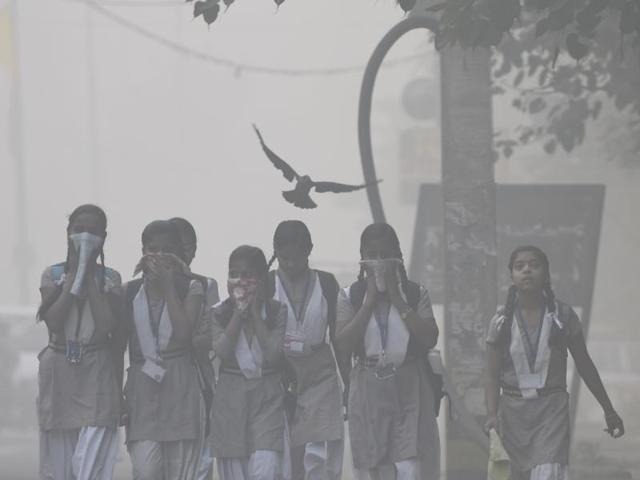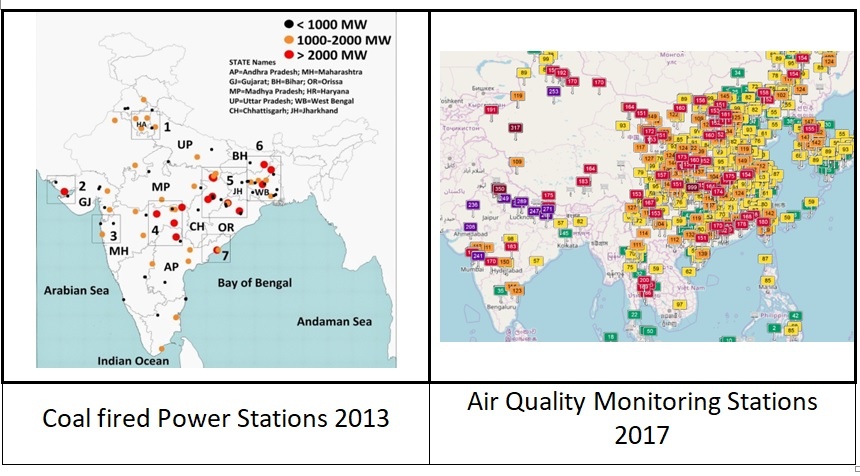The current ‘smog crisis’ in northern India is, literally, the canary in the mine. Increasingly frequent, severe and prolonged air pollution crises need to be bought to an end. The human, economic and environmental costs of not doing so will likely soon be greater than investments needed for renewables and emission controls. Fortunately, means for doing this are at hand, if the Indian people and government have sufficient political will.
While this article was being written in mid-November two important events affecting India’s energy and climate future occurred – one in Bonn the other in India.
This month at UN FCCC Conference of Parties 23 in Bonn, 19 countries pledged to phase out the use of coal. In some countries like the UK this has already almost been achieved. Naturally, much needs to be done to implement these pledges, including getting other countries, like the US, Russia, China and Australia, to sign on.
In northern India during the first half of November 2017 (and continuing) a vast swathe of the nation was blanketed in poisonous smog, caused by ‘dirty power’. Much of it due to burning coal for electricity, added to by burning crop wastes and motor vehicle exhausts, especially from diesel power trucks and buses.
The first event showed that the necessity of abandoning the ‘dirty power’ of coal as quickly as possible now has widespread international political support. Even in countries such as the US and Australia that have not joined the pledge, it is clear that a significant proportion of their citizens agree with the pledge and are taking political and personal action.
The second event showed if it was necessary to repeat the lesson that India’s plans for massive increases in coal-fired electricity generation will lead to ever mounting health and environmental disaster across India. In 2011 health costs for PM2.5 emissions alone from 111 coal-fired power stations were estimated to have cost the Indian public and government USD 3.2-4.6bn. The rapid increase in the number of power stations since then may well have doubled these costs.
The left-hand map below shows the location of coal-fired power stations in 2013, since then many additional stations have been built. There is growing political and economic support for accelerating the switch to grid-scale and micro-grid renewables as quickly as possible. Fortunately, as renewable power capacity can be built much faster and more cheaply than yet more coal-fired power generation, this appears to be a much more feasible path forward.
China is showing that this can be done, on a comparable scale to that of India. Yes, the Chinese government has the deep pockets needed for rapid investment in renewables and emissions control technology that India lacks. India, on the other hand, has a wealth of incredibly creative and technically capable people, especially young professionals scattered across the nation. Moreover, it is also clear that private sector and public-private investments in renewables have accelerated beyond expectations in the last three years. There appear to be no unsurmountable barriers to further broadening and deepening these investments in renewables and, importantly, making the regulatory changes needed to clear the way forward for the transition quicker still.
India & China on How They Fight Air Pollution
It has become common to compare India and China across many dimensions, including pollution. Often the focus is just on air pollution in New Delhi and Beijing, this is a mistake. As the right-hand map below of air quality monitoring in both countries shows, the problems are widespread and often as serious in other parts of each country.
Sources: Left: Air Quality India, http://www.indiaairquality.info/emissions-power-plants/. Right: World Air Quality Index project, map for 18Nov17 (http://aqicn.org/). For further information, including animated forecasts for northern India see: http://aqicn.org/faq/2016-02-28/air-quality-forecasting-in-northern-india/
One of the big differences between China and India – as the map shows – is the number of air pollution monitoring stations – hundreds in China vs. just dozens in India (reportedly some 60). Having detailed, up-to-date air quality data has enabled the Chinese to see how serious the air pollution problem is and take selective action in critical locations and areas. From the above maps it is clear that in India sources of power-station air pollution are generally located far away from air quality monitoring stations. The current plan to install another twenty air quality monitors in the NCR does not even begin to address the deficit – hundreds more stations with the necessary staff are needed across the nation.
Six Solutions
Mounting air pollution in New Delhi and NCR cannot be reduced in isolation from dealing with sources all across the vast industrial and mining swathe from Orissa to Maharashtra, and along the Ganga River valley. China has significantly reduced air pollution during the last decade using a range of measures, many of them quite draconian. One lesson is that it will take a decade or more for India to achieve similar results. There is no quick fix for reducing air pollution, it requires progressively closing worst offenders first and fast, not permitting any more coal-fired plants to be built (including stopping construction), rapidly retrofitting existing plants, well-trained staff and strengthened regulation and monitoring.
There are two separate but related pollution challenges. First, cleaning up existing sources of air pollution, second, minimising future air pollution. Each requires different approaches from communities and public and private sectors. Tackling the second challenge without, simultaneously, tackling the first makes little sense – historical sources of pollution have to be cleaned up. Most of this article is devoted to a renewable energy future for India, the second challenge.
First some suggestions about what might be done to tackle the critical smog problem in northern India now choking and sickening millions of people.
Here are some ideas for action:
- Require all politicians and all senior government officials in NCR to walk to work at least one day every week. Looking out the window and going tut-tut is not sufficient. This is suggested so they get a weekly first-hand experience, of what it really means to breathe in and cough out on the smog.
- As quickly as possible construct solar PV facilities with equal or greater capacity to selected power stations, with grid-scale battery storage; starting with the oldest and worst polluting first. These could be on or adjacent to the land occupied by the power station, or on city outskirts next to major transmission lines. Progressively decommission each coal-fired power station as its solar PV facility is constructed and progressively comes on-line.
For example, recent analysis of relative costs shows replacing coal-fired with zero-emissions renewable generation is much cheaper than thought only a short time ago. Equally important, complementary analysis shows renewables can reliably provide up to 50% of grid power. Taken together, this suggests switching as rapidly as possible to renewables is both economically and technically attractive.
Experience to-date in India suggests 300 – 500 MW solar PV facilities can be constructed within about a year; many power stations can be converted in parallel; makes use of existing power transmission infrastructure. Interim legislation and guidelines will be needed to establish ownership, operational and management frameworks. Power station workers can be retrained, coal storage areas be progressively emptied and replaced with solar PV arrays.
- In parallel, begin retrofitting pollution control (GHG and particulate) equipment, again starting with the worst first, where insufficient land for solar PV facilities is available at a power station. Pollution control technology selected for specific emissions should be based on available international standards and experience, using equipment suitable for construction in India by Indian firms and workers (Make in India).
Cost-sharing arrangements between governments (national, state) will be required to ensure sufficient funds are available as needed. Concessional loans, linked to verified emissions reductions, could be used to speed private sector investments. Operational costs should probably be borne by station operators, public or private.
- Rapidly increase the number of air pollution monitoring stations, especially across northern India, locations to be selected, in part, on the basis of local air pollution knowledge. The aim would be to have at least two hundred installed, staffed and operational within one year; stations to be relocated as necessary.
- Aggressively implement the new air pollution control standards for coal-fired power stations. In late 2015 India issued revised pollution control standards for coal-fired power stations. For the first time these included SO2, NOx, and mercury emissions. Different standards apply to power stations installed before 2004, between 2004 and 2016, and from 2017 forward; standards for new power stations are more stringent than older ones. One expert estimate is that full implementation of flue gas desulphurisation standards would result in an immediate 50% drop in PM5 emissions. The current smog crisis in northern India clearly shows these standards are not yet effective and/or being strictly enforced. This must change, and quickly.
Explore progressive tightening of standards based on continuing monitoring of air pollution levels in the affected area/region. In addition, impose pollution charges on monitored and measured emissions. Charges could be set and adjusted to encourage verified installation and operation of pollution control equipment; revenue collected could be used to finance investments in air pollution control.
- Communities near and downwind of power stations are the most severely affected by toxic emissions. Local capacity to better monitor and report emissions would complement and expand state governments’ currently limited capabilities. This could be achieved by encouraging and supporting community participation in air pollution monitoring, especially of power stations in urban and peri-urban areas.
Municipal authorities could provide means for communities to become ‘first line’ observers and reporters of power station operations and emissions, including providing basic skills and instruments. School projects could be used to educate students on the importance of good air quality and how to monitor air pollution. Local reports could be collated and analysed at municipal and state levels, and used to guide official pollution control and legal actions.
India’s Coal-energy Policy ‘Wrong-headed’
There is a serious fallacy underlying current energy policy in India. Because coal is supposedly ‘cheaper’ than renewables – it is not – and India is ‘poor’ and tens of millions need electricity, it claims burning coal is the best way to meet this unmet and growing demand. This is simply wrong headed. India, like other countries, cannot afford to use ‘second best’ energy technologies. It is now apparent that hidden human and environmental costs are much greater than supposed savings. That renewables are now significantly cheaper and cleaner just exacerbates this error. The lesson is abundantly clear: burning coal needs to be stopped as quickly as possible – renewable energy technology can now do the job.
This is written against the background awareness that India and China have become the world’s major sources of GHG emissions. Population growth and economic expansion make it likely India will soon be the world’s greatest source of GHG emissions.
About the author
 Sean Foley was born in London, grew up in Australia. He travelled widely in India for six months in 1969-70, has visited many times since. Almost continuously since early 1980s living and working in Asia (Indonesia, Philippines, Vietnam, Cambodia, Bangladesh, India, Nepal, Laos, Thailand, Timor Leste) as an independent consultant – a total of some 20 years based in Indonesia plus 14 years in Laos.
Sean Foley was born in London, grew up in Australia. He travelled widely in India for six months in 1969-70, has visited many times since. Almost continuously since early 1980s living and working in Asia (Indonesia, Philippines, Vietnam, Cambodia, Bangladesh, India, Nepal, Laos, Thailand, Timor Leste) as an independent consultant – a total of some 20 years based in Indonesia plus 14 years in Laos.
In the last 20 years he has led many project teams working on watershed and environmental management, community development, renewable energy, agriculture, forest and biodiversity conservation, reducing carbon emissions (REDD), and managing hydropower social and environmental impacts.
BSc (Hons) Natural Resource Management, PhD Human Ecology (“The Ecological Transition in Bali”), Fellow Royal Geographical Society. Seven years as Chairman of The Samdhana Institute, SE Asia.












[…] 6 Solutions to Delhi’s Air Pollution Problem […]